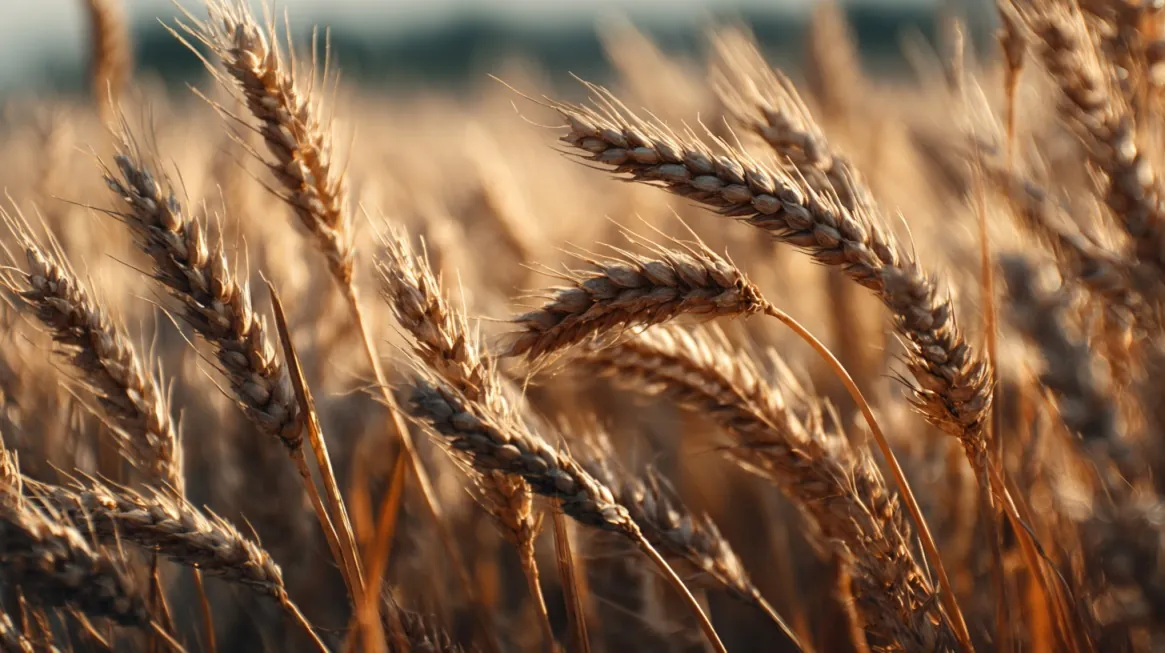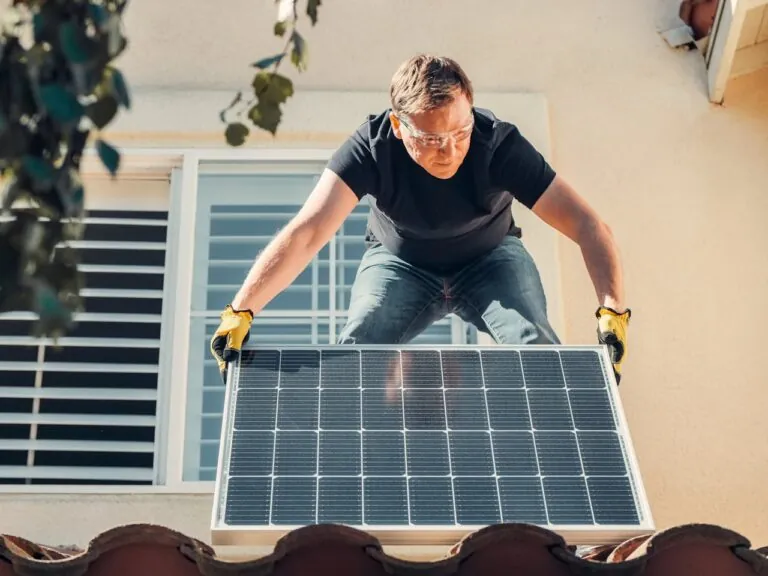Farmers and researchers now ask one straightforward question. What is agrovoltaics? It means growing crops under solar panels without reducing food production. Fields can now produce food and electricity on the same land. This solution helps address food security, land scarcity, and the demand for clean energy.
The practice began with test fields in Europe and Asia, where universities partnered with farms to measure productivity under shade. Results showed that even during heatwaves, crops under panels remained stable. Agrovoltaics emerged not as a trend, but as a response to growing concerns over land-use conflicts.
Solar developers often target fertile farmland, forcing farmers to choose between increasing food production and generating power. Agrovoltaics bridges that divide by allowing both sectors to share a single field without compromise.
In 2025, interest in this model rises sharply due to extreme weather, global food inflation, and energy supply disruptions. Policymakers now see dual-use land as critical to rural sustainability.
Farmers who once feared solar projects now join cooperatives to build shared systems. Agrovoltaics transforms the concept of farming into a diversified, climate-aware practice where the sun becomes both a fuel source and a farming partner.
How Dual-Use Agrovoltaic Systems Provide an Engineered Balance
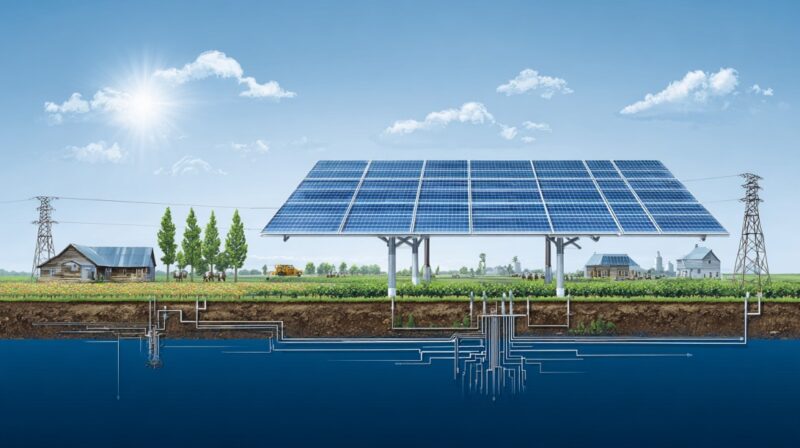
Agrovoltaic systems combine agriculture and photovoltaic technology. Solar panels sit above rows of crops at a specific height. Sunlight filters through gaps, creating a microclimate below. Shade cools the soil and reduces evaporation. Water use becomes more efficient without reducing yield.
Panels tilt based on solar movement. Some rotate during the day to maximize light and redirect rainwater. Engineers design systems by measuring light, soil needs, and plant responses. Crops like lettuce, berries, and beans adapt well to filtered light. Taller crops, such as corn, require wider spacing or vertical configurations.
Farmers in dry zones often report better harvests under partial shading, especially during extreme heat periods. Microclimate regulation helps reduce stress-related plant disorders. Some farms in Asia and Latin America are now experimenting with seasonal crop changes that depend on the availability of sunlight.
Longer-term experiments have demonstrated improved soil health in dual-use fields with reduced tillage and lower erosion. The flexible structure of the panels allows farms to adjust their layout over time.
Key Economic and Agricultural Benefits of Agrovoltaic Farming
Agrovoltaic farming offers several clear benefits. Farmers earn income from crop sales and energy production. Land earns more revenue per acre. Shade from solar panels reduces heat stress and water use. Plants remain cooler, and the soil retains moisture for more extended periods.
Solar energy and farming create jobs. Technicians maintain the panels, and farmers gain training on system operations. A study in Germany found that dual-use solar agriculture can raise land productivity by up to 60 percent. In dry areas, crop survival rates improve with partial shade.
Farmers also gain resilience. If crops fail due to unexpected weather, solar energy can still provide an income. Energy harvested during summer peaks can supply nearby irrigation pumps or cooling systems, providing a valuable resource. In addition, cooperative farms often invest jointly in agrovoltaic projects to lower startup costs. Insurance models also evolve to support these integrated operations.
Which Crops Perform Best
Not every plant is suitable for agrovoltaic settings. Certain crops thrive with lower light. Leafy greens, root vegetables, and herbs perform well. Strawberries and tomatoes also adapt when spaced correctly.
Farmers avoid tall crops unless they install panels at a higher level. Root systems must match the soil conditions below the panels. Spinach, kale, radishes, and onions show strong results in controlled tests. Yield comparisons demonstrate that certain crops grow more effectively under partial shade than in full sunlight.
In cooler climates, brassicas such as cabbage and cauliflower handle filtered light well. In tropical zones, taro and sweet potatoes perform reliably under solar arrays. Mushrooms have shown promise in deeply shaded systems paired with solar batteries.
Agricultural researchers also trial flowers such as marigolds and lavender to improve pollination and deter pests. Matching soil pH and structure to crop root behavior is essential.
| Crop Type | Preferred Conditions | Panel Setup |
| Leafy Greens (Spinach, Kale) | Cool, moist soils | Fixed panels with 40–50% light transmission |
| Root Vegetables (Radishes, Carrots) | Loose, deep soil | Elevated panels for even spacing |
| Strawberries, Tomatoes | Temperate zones, filtered light | Adjustable or rotating arrays |
| Herbs (Basil, Thyme) | Dry, well-drained soil | Partial shading, high ventilation |
| Mushrooms | High humidity, low light | Dense shading with moisture-retaining soil |
Common Agrovoltaic System Designs
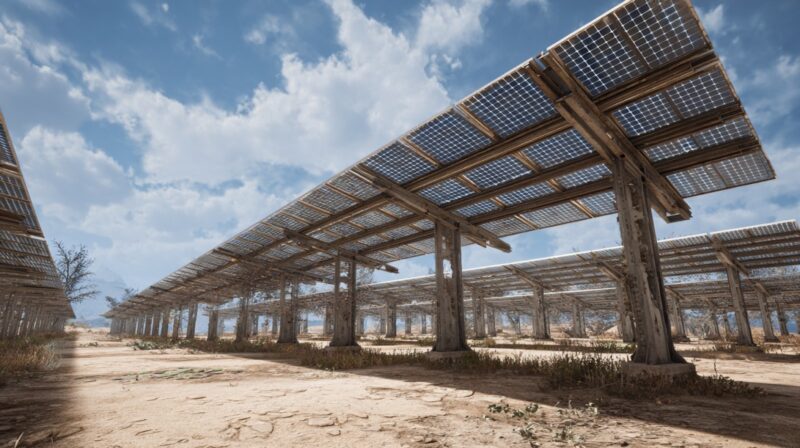
Agrovoltaic systems vary by design. Fixed-panel systems remain at one angle. They cost less but offer less flexibility. Tracking systems rotate throughout the day. This boosts power production by up to 30 percent.
Vertical solar arrays allow space for tractors and livestock. Bifacial panels capture light from both sides. Some systems utilize raised structures to allow shade-loving crops to grow underneath. Experts choose system types based on region, crop type, and slope of the land.
Farmers with rolling land prefer adjustable mounts. Flatlands favor wide panel setups with efficient tracking. In flood-prone areas, elevated arrays help protect both equipment and crops. Temporary or mobile panels also exist for seasonal or migratory farms. Shade intensity and airflow design have a direct influence on fungal risk and yield consistency.
| Type | Description | Best Use |
| Fixed Tilt | Panels stay in place | Low-cost farms with stable crops |
| Tracking | Panels move with the sun | Maximizes energy output |
| Vertical | Panels set upright | Allows space for machinery |
| Bifacial | Light is captured on both sides | High-reflective soil areas |
Cutting-Edge Solar Panel Farming Technology
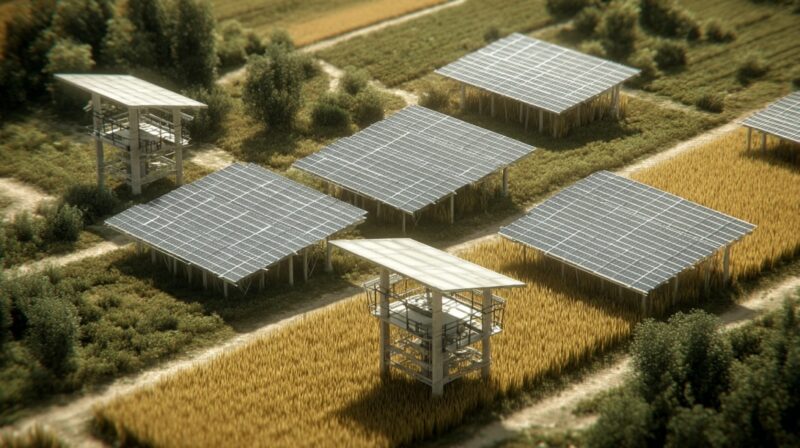
Technology plays a key role in agrovoltaics. Sensors monitor soil moisture and adjust irrigation. AI systems balance light needs for crops and energy output. Remote platforms track performance and schedule maintenance.
Drip systems can be combined with rain capture to reduce water waste. Lightweight solar panels reduce pressure on structures. Some farms integrate battery storage to power local operations. Smart inverters control the amount of energy returned to the grid.
New materials, such as semi-transparent organic solar panels, are now being tested for their potential to improve plant photosynthesis. Flexible polymers resist the weather better than glass. Real-time dashboards enable farmers to view power output, soil data, and plant growth all in one place.
Solar-integrated drones assist in mapping fields and spotting crop issues before harvest loss. Hardware improvements enable farmers to scale their systems on a modular basis.
| Technology | Function | Impact |
|---|---|---|
| Soil Moisture Sensors | Monitor water levels | Improve irrigation and conserve water |
| AI Optimization | Adjust light angles | Balance energy yield and crop health |
| Drip Irrigation | Deliver water to the roots | Reduce evaporation losses |
| Flexible Panels | Resist weather damage | Extend lifespan in harsh climates |
| Solar Drones | Scan crops and panels | Detect issues early, reduce losses |
Global Case Studies
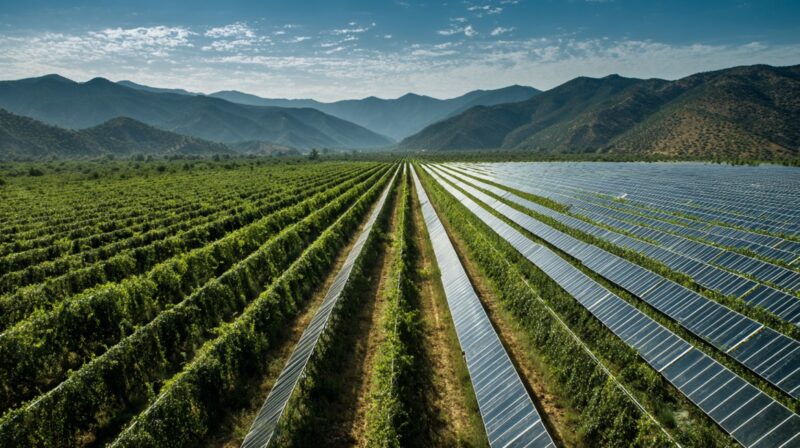
Countries now test agrovoltaics at different scales. In Japan, solar arrays share rice fields. In France, vineyards grow grapes under vertical panels. The Netherlands supports agrovoltaics with subsidies for dual-use farms.
In Arizona, a research farm tested peppers and carrots under elevated arrays. The crops grew faster and needed less water. One farmer in Oregon tripled revenue per acre by combining berries with solar energy. Germany leads Europe with over 80 test farms under government programs.
In Kenya, shade from solar panels extends the growing season for native greens. Morocco uses agrovoltaics to cool desert soils and reduce irrigation waste. South Korea invests in solar farms with greenhouse integration. Australia explores combinations with sheep grazing to control weeds and power fencing. Field evidence confirms crop resilience, improved biodiversity, and financial stability.
| Country | Support Program | Details |
| Germany | Agri-PV Program | Subsidies for pilot farms |
| France | Vineyard Projects | Fund vertical installations |
| India | KUSUM Scheme | Solar pumps and dual-use panels |
| USA | USDA REAP | Grants for rural solar farms |
Sustainability and Climate-Resilient Benefits
Agrovoltaics supports climate-smart agriculture. Less irrigation reduces groundwater depletion. Plants stay healthy with fewer chemical inputs. Soil erosion drops under partial shade.
Solar panels reduce reliance on fossil fuels. Farms can power greenhouses and cold storage facilities without relying on external sources. Agrovoltaic systems help meet renewable energy goals. Food production and clean energy can work together.
Carbon savings per acre increase when fossil fuel-based water pumping stops. Shade lowers peak ground temperatures, which reduces heatwave crop damage. Soil microbiomes also benefit from more stable surface conditions. Research from 2024 indicates that multi-season agrovoltaic plots emit 25 percent fewer greenhouse gases than conventional farms. Sustainability reporting tools now track the impact of agrovoltaic systems.
Policy Incentives and Economic Models
Initial costs remain high. Installation requires careful planning, suitable equipment, and necessary permits. Return on investment improves over time. Energy sales reduce risk during crop failures.
Policy helps drive adoption. Government incentives include tax credits, grants, and feed-in tariffs. Some regions classify dual-use systems as agricultural land, lowering taxes. Banks now offer loans for solar panel farming technology.
Community solar cooperatives reduce cost barriers. Insurance programs begin to cover panel damage and crop interaction. Farm unions push for zoning reform to allow more agrovoltaic development. Solar leasing options provide small farmers with access to solar energy without requiring a full capital investment. Economic modeling now includes food prices, weather risk, and energy grid demand.
How a Family in Portugal Turned Their Struggling Olive Grove
Rui inherited his family’s olive grove near Évora, but after years of drought and poor yields, he was on the verge of giving up. He learned about agrovoltaics through a local farm program and applied for funding. They installed adjustable panels across the grove, keeping just enough space for the sun to reach the trees.
Within two years, olive yields improved. The soil retained more water, and Rui reduced his irrigation by half. He also began selling energy to a local microgrid. His family now enjoys a stable income and proudly shares the system with nearby schools as an example of rural innovation.
Looking Ahead
The future looks promising. More land can support both food and clean energy. Crop selection tools help match plants with system types. Urban farms now explore rooftop agrovoltaics.
Research focuses on panel materials, cooling systems, and automation. Governments test policies to expand access. Developers include agrovoltaic options in new solar farms. The dual-purpose model fits into global food and energy planning.
Farm networks collaborate across continents to exchange crop data and optimize shading. Universities train future engineers and agronomists to expand agrovoltaic design. New markets emerge for crops grown under climate-controlled microzones. Experts see agrovoltaics as a foundation of food-energy resilience.








